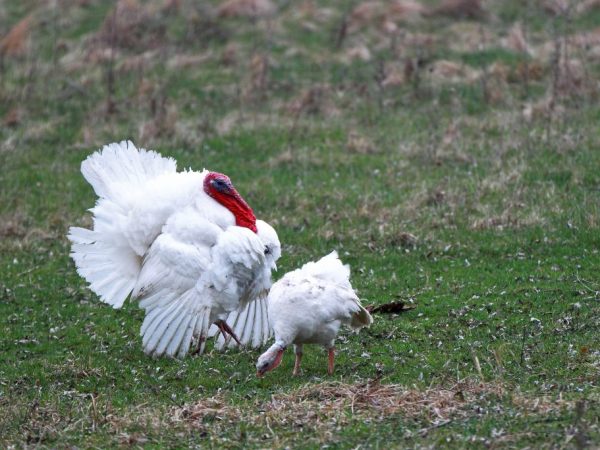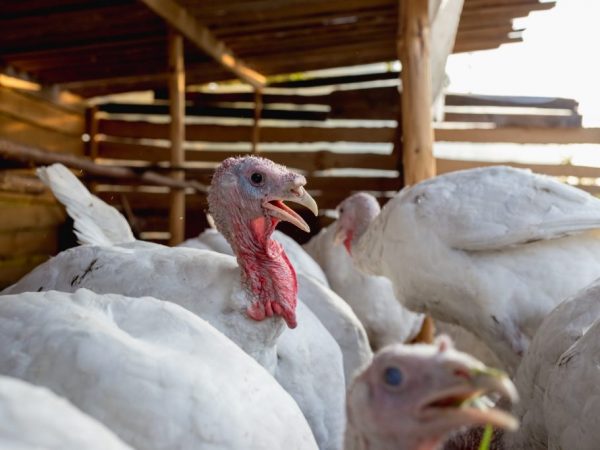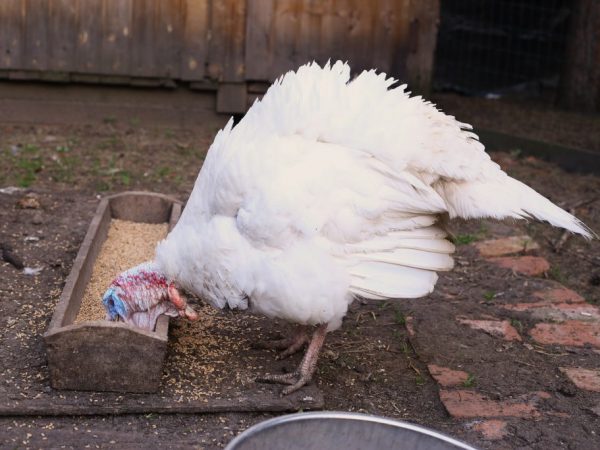Maintenance and care of turkeys
Turkey poults in the conditions of a private farm today are often grown for meat production and subsequent use in breeding work. The preservation and increase of the turkey population depends on the properly organized maintenance and care of Turkey poults. Turkey poults in the future are large poultry, therefore, when breeding turkeys, the choice of the method of keeping young livestock and properly organized feeding with the necessary diet is of no small importance. It also depends on how many Turkey poults will grow to the desired size and at what rate of intensity they will gain weight.
- Cell culture method
- Walking cultivation
- Cultivation by open walking method
- Growing in aviaries
- Comfort requirements
- The specifics of feeding young animals
- Initial diet
- Age from 1 week to 1 month
- Age up to 2 months
- From 2 months to slaughter
- Most common diseases
- Smallpox disease
- Mycoplasmosis
- Worms
- Newcastle disease
- Diseases of the feet
- White diarrhea
- Goiter diseases
- Pecking Cases

Maintenance and care of turkeys
Cell culture method
Only lungs are suitable for the cage method of keeping turkey poults turkey breeds, not distinguished by large intensive weight gain. When placing young animals in a cage, it must be remembered that the stocking rate for birds is no more than two individuals per cage. In this case, males and females of turkeys are kept separately.
The maximum period for the cage content of turkeys is until they reach four months of age. Farmers give the greatest preference for cage rearing keeping young stock up to 1.5 months with their subsequent sale.
Among the main advantages of the cage keeping of poultry:
- the possibility of saving space by arranging cages with birds in a tiered way, while the efficiency of using free space is doubled,
- the opportunity to have a larger number of turkey poults arising from space savings with a potential of 1.7-1.8 times,
- simplified care of young animals with the subsequent increase in the productivity of technical personnel in industrial production, reduction in the time for caring for turkey poults in a private farm.
However, with a cage mode of keeping turkeys, the disadvantages of this method exceed its advantages:
- Turkey poults suspend the growth rate, starting from one month of age,
- the rate of turkey reproduction of birds is lost,
- diseases of the joints of the legs appear (arthritis) due to the reduction in conditions of limited space of physical activity and lack of physical activity,
in some cases, wing fractures are observed due to the large span in tight cell conditions.
In addition, in the conditions of cage growing of turkey poults, farmers often note the tendency of birds to fearful behavior, due to which they react to loud sounds, begin to trample each other and beat in locked cages, receiving numerous injuries.Also, with limited living in poultry, excessive accumulation of fat cells in the liver was noted.
Walking cultivation
The walking method of keeping poultry is preferred by most breeders as it provides the greatest comfort for the chicks. It can be in one of two ways - in the form of open walking and by keeping in aviaries.
Cultivation by open walking method
It is optimal for breeding turkeys, but is directly tied to the constant presence of a person, since during the day Turkey poults go outside to grazing areas. The turkey livestock serves itself on its own: it finds food, pecking not only vegetation, but also eating insects, satisfies physiological needs directly in the walking areas.
At the onset of maturity on the open range, turkeys and turkeys are grazed separately.
For open walking, a turkey is suitable, which is already 1.5 months old. Among the main advantages of such content:
- increase in reproduction rates,
- increasing the immunity of birds due to the intake of natural vitamins,
- reduction of financial costs for feed,
- improving the physiological well-being of birds due to constant physical activity,
- increasing the growth rate of turkeys and poults,
- no additional capital investments and simplified care.
Before the turkey herd is released into the open area, it is examined for the presence of open hatches and holes, as well as for the presence of foreign objects that can threaten the life and health of the birds.
Growing in aviaries
With the open-air cage keeping of turkey poults, it is necessary to provide the proper space at the rate of at least 10 square meters per individual.
For aviary cultivation, they try not to combine turkey poults, the age of which differs among themselves by more than two weeks.
The bird must be provided with free space for walking
Some farmers, if there is enough space, try to fence off two free plots, which they change for walking and grazing poultry. In the absence of the possibility of grazing, the birds are additionally fed with fresh greens when kept in an aviary.
Comfort requirements
After the turkey poults hatch, they leave nests and are planted in separately prepared boxes and create the necessary microclimate in the room. The birth of chicks most often occurs in the spring, a little less often in the autumn, therefore the maintenance of the thermal regime is often provided with the help of artificial heating using heaters and by warming the room. In summer, the temperature in the room should not exceed 25 degrees, and in winter it should not fall below 5. To regulate heat exchange, they resort to airing and ventilation. The room must be equipped feeders and drinkers.
The specifics of feeding young animals
A balanced diet allows for an intensive weight gain of turkeys, birds should weigh up to 20-30 kilograms. The feeding rates given to the young, per chick, are given in the table:
| age, weeks | Feeding rate, grams |
| 1 | 10 |
| 2 | 25 |
| 3 | 40 |
| 4 | 60 |
| 5 | 75 |
| 6 | 90 |
| 7 | 110 |
| 8 | 130 |
| 9 | 155 |
| 10 | 175 |
| 11 | 200 |
| 12 | 220 |
| 13 | 235 |
| 14 | 250 |
| 15 | 260 |
| 16 | 280 |
| 17 | 285 |
| 18 | 290 |
| 19 | 295 |
| 20 | 295 |
| 21 | 300 |
| 22 | 305 |
| 23 | 310 |
| 24 | 310 |
| 25 | 300 |
For adults, the daily intake will be 260 grams for females and 500 grams for males. It is possible to feed with a standardized feeding method using balanced feed mixtures. With a predominantly natural diet, turkeys should be fed ad libitum.
Initial diet
At the first birth, when the chick has just hatched, it is soldered with water, to which glucose is added. Only after eight to ten hours the turkey poults are given the first food, for a start they make a mixture, which includes a crushed egg with corn flour and wheat bran, from which you can make small balls with your hands and put on a paper bed. You can watch the video how to make food yourself.
Until a week of age, cottage cheese is present in the diet of young animals, they are given green vitamins in the form of dandelion, nettle, milkweed, alfalfa, green onions.
To avoid indigestion, the introduction of new feed for turkey poults is done gradually. The Purina compound feed has proven to be good.
After three to five days, wheat mash is added to the feeding ration, then barley and oatmeal are given.
The frequency of feeding turkeys up to one week of age is by day - with an interval of three hours. This is the time when they mostly sleep.
Age from 1 week to 1 month

Access to water must be free
During this period of active growth, the total percentage of greenery increases and is brought to an indicator of 30%. The most suitable meals under one month of age will be balanced ready-to-eat foods. feed mixtures, and when they are introduced into feeding, the proportion should not be more than 15 percent of the total feed volume, so that the birds grow and gain weight fully. Drinking bowls with water are installed for unlimited access to them.
With an increase to reaching the age of one month, when individuals should weigh up to 2 kilograms, we can talk about a properly selected diet.
from the age of 2 weeks to 1 month, chalk and flour are mixed into turkey feed.
The frequency of feeding up to one month of age - with an interval of four hours.
Age up to 2 months
A month-old turkey is gradually switching to three meals a day, as growth activity begins to subside. The bulk of the feed ration falls on cereals, greens, bran and corn. At the same time, it is necessary to increase the volume of protein feed by adding meat and fish waste to the feed.
From 2 months to slaughter
The age of two months practically does not differ from the previous one, only the part of grain crops in the amount of nutrition increases. Turkey poults are transferred to the walking method.
With the set goal raise turkey poults for meat they can be fattened up to five months of age, when the price of the feed justifies the result after slaughter. For the purpose of breeding reproduction, an adult male can be kept for up to two years, a female for up to three years.
Most common diseases
Caring for Turkey poults in the process of keeping and growing them involves timely prevention and treatment of those characteristic of poultry. diseases... The preservation of the livestock depends on the measures taken on time.
Smallpox disease
Smallpox is transferred from sick individuals with the help of insects and leads to the destruction of sick livestock and vaccination of healthy embryo vaccines at the age of 6 weeks. The initial symptoms are youngsters' refusal to eat, ruffled feathers and drooping wings.
Mycoplasmosis
Mycoplasmosis is transmitted from sick individuals and is provoked by lowered immunity associated with a violation of the care of Turkey poults. It leads to disruption of the respiratory organs and inflammation of the eyes. Among the signs - impaired coordination of movements. For treatment, you need to show sick turkeys to a veterinarian, after which you can prescribe drugs of the antibiotic group (erythromycin or chloramphenicol).
Worms
The earth, helminth eggs in the droppings, sick individuals and food act as sources of worms. For treatment and prevention, anthelmintic drugs should be given.
Newcastle disease
An infectious disease leads to paralysis of the paws, cannot be treated, but requires a vaccine with a medicine against the pathogen. As a preventive measure, vitamins and mineral supplements are given, and the volume of fresh herbs is increased. Many farmers have a trivit in their home medicine cabinet for this purpose.
Diseases of the feet
It occurs as a result of a decrease in physical activity due to the large weight of the bird. In this case, the paws often swell, the birds limp and fall. As a preventive measure, the dose of calcium-containing products is increased by adding cottage cheese, shellfish, chalk.
White diarrhea
Pullorosis is an infectious disease that affects the intestines. Usually occurs at 1 month of age. Causes of the disease - the causative agent of the group of salmonellosis is manifested by a decrease in appetite and weakness, fever and loose stools, the bird loses weight. It is treated with antibiotics.
Goiter diseases
The reason for the hardening of the goiter is a malnutrition, which is reduced to solid food. In such cases, for better processing of grain, you need to add shell and chalk.
Pecking Cases
The reasons for pecking can be during the period of active growth, when Turkey poults pluck out feathers or individual parts of the body. Pecking can appear due to improperly selected nutrition with a deficiency of vitamins, especially amino acids. The field of revision of the forage ration usually disappears after pecking.



